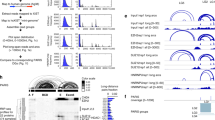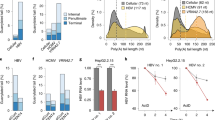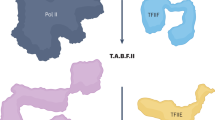Abstract
The SAM domain of the Saccharomyces cerevisiae post-transcriptional regulator Vts1p epitomizes a subfamily of SAM domains conserved from yeast to humans that function as sequence-specific RNA-binding domains. Here we report the 2.0-Å X-ray structure of the Vts1p SAM domain bound to a high-affinity RNA ligand. Specificity of RNA binding arises from the association of a guanosine loop base with a shallow pocket on the SAM domain and from multiple SAM domain contacts to the unique backbone structure of the loop, defined in part by a nonplanar base pair within the loop. We have validated NNF1 as an endogenous target of Vts1p among 79 transcripts that copurify with Vts1p. Bioinformatic analysis of these mRNAs demonstrates that the RNA-binding specificity of Vts1p in vivo is probably more stringent than that of the isolated SAM domain in vitro.
This is a preview of subscription content, access via your institution
Access options
Subscribe to this journal
Receive 12 print issues and online access
$189.00 per year
only $15.75 per issue
Buy this article
- Purchase on Springer Link
- Instant access to full article PDF
Prices may be subject to local taxes which are calculated during checkout






Similar content being viewed by others
References
Kloc, M., Zearfoss, N.R. & Etkin, L.D. Mechanisms of subcellular mRNA localization. Cell 108, 533–544 (2002).
Dreyfuss, G., Kim, V.N. & Kataoka, N. Messenger-RNA-binding proteins and the messages they carry. Nat. Rev. Mol. Cell Biol. 3, 195–205 (2002).
Moore, M.J. From birth to death: the complex lives of eukaryotic mRNAs. Science 309, 1514–1518 (2005).
Smibert, C.A., Wilson, J.E., Kerr, K. & Macdonald, P.M. smaug protein represses translation of unlocalized nanos mRNA in the Drosophila embryo. Genes Dev. 10, 2600–2609 (1996).
Smibert, C.A., Lie, Y.S., Shillinglaw, W., Henzel, W.J. & Macdonald, P.M. Smaug, a novel and conserved protein, contributes to repression of nanos mRNA translation in vitro. RNA 5, 1535–1547 (1999).
Dahanukar, A., Walker, J.A. & Wharton, R.P. Smaug, a novel RNA-binding protein that operates a translational switch in Drosophila. Mol. Cell 4, 209–218 (1999).
Semotok, J.L. et al. Smaug recruits the CCR/POP2/NOT deadenylase complex to trigger maternal transcript localization in the early Drosophila embryo. Curr. Biol. 15, 284–294 (2005).
Gavis, E.R. & Lehmann, R. Translational regulation of nanos by RNA localization. Nature 369, 315–318 (1994).
Nelson, M.R., Leidal, A.M. & Smibert, C.A. Drosophila Cup is an eIF4E-binding protein that functions in Smaug-mediated translational repression. EMBO J. 23, 150–159 (2004).
Aviv, T. et al. The RNA-binding SAM domain of Smaug defines a new family of post-transcriptional regulators. Nat. Struct. Biol. 10, 614–621 (2003).
Green, J.B., Gardner, C.D., Wharton, R.P. & Aggarwal, A.K. RNA recognition via the SAM domain of Smaug. Mol. Cell 11, 1537–1548 (2003).
Kim, C.A. et al. Polymerization of the SAM domain of TEL in leukemogenesis and transcriptional repression. EMBO J. 20, 4173–4182 (2001).
Kim, C.A., Gingery, M., Pilpa, R.M. & Bowie, J.U. The SAM domain of polyhomeotic forms a helical polymer. Nat. Struct. Biol. 9, 453–457 (2002).
Kim, C.A., Sawaya, M.R., Cascio, D., Kim, W. & Bowie, J.U. Structural organization of a Sex-comb-on-midleg/polyhomeotic copolymer. J. Biol. Chem. 280, 27769–27775 (2005).
Dahanukar, A. & Wharton, R.P. The Nanos gradient in Drosophila embryos is generated by translational regulation. Genes Dev. 10, 2610–2620 (1996).
Gavis, E.R., Lunsford, L., Bergsten, S.E. & Lehmann, R. A conserved 90 nucleotide element mediates translational repression of nanos RNA. Development 122, 2791–2800 (1996).
Bergsten, S.E. & Gavis, E.R. Role for mRNA localization in translational activation but not spatial restriction of nanos RNA. Development 126, 659–669 (1999).
Baez, M.V. & Boccaccio, G.L. Mammalian smaug is a translational repressor that forms cytoplasmic foci similar to stress granules. J. Biol. Chem., published online 12 October 2005 (10.1074/jbc.M508374200).
Aviv, T. et al. The NMR and X-ray structures of the Saccharomyces cerevisiae Vts1 SAM domain define a surface for the recognition of RNA hairpins. J. Mol. Biol. (in the press).
Brunger, A.T. et al. Crystallography and NMR system: a new software suite for macromolecular structure determination. Acta Crystallogr. D Biol. Crystallogr. 54, 905–921 (1998).
Ennifar, E. et al. The crystal structure of UUCG tetraloop. J. Mol. Biol. 304, 35–42 (2000).
Yoshizawa, S. et al. Structural basis for mRNA recognition by elongation factor SelB. Nat. Struct. Mol. Biol. 12, 198–203 (2005).
Klosterman, P.S., Hendrix, D.K., Tamura, M., Holbrook, S.R. & Brenner, S.E. Three-dimensional motifs from the SCOR, structural classification of RNA database: extruded strands, base triples, tetraloops and U-turns. Nucleic Acids Res. 32, 2342–2352 (2004).
Kellis, M., Birren, B.W. & Lander, E.S. Proof and evolutionary analysis of ancient genome duplication in the yeast Saccharomyces cerevisiae. Nature 428, 617–624 (2004).
Hieronymus, H. & Silver, P.A. Genome-wide analysis of RNA-protein interactions illustrates specificity of the mRNA export machinery. Nat. Genet. 33, 155–161 (2003).
Shepard, K.A. et al. Widespread cytoplasmic mRNA transport in yeast: identification of 22 bud-localized transcripts using DNA microarray analysis. Proc. Natl. Acad. Sci. USA 100, 11429–11434 (2003).
Gerber, A.P., Herschlag, D. & Brown, P.O. Extensive association of functionally and cytotopically related mRNAs with Puf family RNA-binding proteins in yeast. PLoS Biol. 2, E79 (2004).
Engebrecht, J., Masse, S., Davis, L., Rose, K. & Kessel, T. Yeast meiotic mutants proficient for the induction of ectopic recombination. Genetics 148, 581–598 (1998).
Zubenko, G.S. & Jones, E.W. Protein degradation, meiosis and sporulation in proteinase-deficient mutants of Saccharomyces cerevisiae. Genetics 97, 45–64 (1981).
Athenstaedt, K. & Daum, G. 1-Acyldihydroxyacetone-phosphate reductase (Ayr1p) of the yeast Saccharomyces cerevisiae encoded by the open reading frame YIL124w is a major component of lipid particles. J. Biol. Chem. 275, 235–240 (2000).
Deutschbauer, A.M., Williams, R.M., Chu, A.M. & Davis, R.W. Parallel phenotypic analysis of sporulation and postgermination growth in Saccharomyces cerevisiae. Proc. Natl. Acad. Sci. USA 99, 15530–15535 (2002).
Li, L., Chen, O.S., McVey Ward, D. & Kaplan, J. CCC1 is a transporter that mediates vacuolar iron storage in yeast. J. Biol. Chem. 276, 29515–29519 (2001).
Satyanarayana, C., Schroder-Kohne, S., Craig, E.A., Schu, P.V. & Horst, M. Cytosolic Hsp70s are involved in the transport of aminopeptidase 1 from the cytoplasm into the vacuole. FEBS Lett. 470, 232–238 (2000).
Wichmann, H., Hengst, L. & Gallwitz, D. Endocytosis in yeast: evidence for the involvement of a small GTP-binding protein (Ypt7p). Cell 71, 1131–1142 (1992).
Dilcher, M., Kohler, B. & von Mollard, G.F. Genetic interactions with the yeast Q-SNARE VTI1 reveal novel functions for the R-SNARE YKT6. J. Biol. Chem. 276, 34537–34544 (2001).
Hadwiger, J.A., Wittenberg, C., Richardson, H.E., de Barros Lopes, M. & Reed, S.I. A family of cyclin homologs that control the G1 phase in yeast. Proc. Natl. Acad. Sci. USA 86, 6255–6259 (1989).
Edwards, M.C. et al. Human CPR (cell cycle progression restoration) genes impart a Far-phenotype on yeast cells. Genetics 147, 1063–1076 (1997).
Li, Y. et al. The mitotic spindle is required for loading of the DASH complex onto the kinetochore. Genes Dev. 16, 183–197 (2002).
Sudbery, P.E., Goodey, A.R. & Carter, B.L. Genes which control cell proliferation in the yeast Saccharomyces cerevisiae. Nature 288, 401–404 (1980).
Dahmann, C., Diffley, J.F. & Nasmyth, K.A. S-phase-promoting cyclin-dependent kinases prevent re-replication by inhibiting the transition of replication origins to a pre-replicative state. Curr. Biol. 5, 1257–1269 (1995).
Shan, X., Xue, Z., Euskirchen, G. & Melese, T. NNF1 is an essential yeast gene required for proper spindle orientation, nucleolar and nuclear envelope structure and mRNA export. J. Cell Sci. 110, 1615–1624 (1997).
Shafaatian, R., Payton, M.A. & Reid, J.D. PWP2, a member of the WD-repeat family of proteins, is an essential Saccharomyces cerevisiae gene involved in cell separation. Mol. Gen. Genet. 252, 101–114 (1996).
Wang, X., McLachlan, J., Zamore, P.D. & Hall, T.M. Modular recognition of RNA by a human pumilio-homology domain. Cell 110, 501–512 (2002).
Wimberly, B.T., Guymon, R., McCutcheon, J.P., White, S.W. & Ramakrishnan, V. A detailed view of a ribosomal active site: the structure of the L11-RNA complex. Cell 97, 491–502 (1999).
Ho, Y. et al. Systematic identification of protein complexes in Saccharomyces cerevisiae by mass spectrometry. Nature 415, 180–183 (2002).
Kabsch, W. Automatic processing of rotation diffraction data from crystals of initially unknown symmetry and cell constants. J. Appl. Crystallogr. 26, 795–800 (1993).
Storoni, L.C., McCoy, A.J. & Reed, R.J. Likelihood-enhanced fast rotation functions. Acta Crystallogr. D Biol. Crystallogr. 60, 432–438 (2004).
Lu, X.J. & Olson, W.K. 3DNA: a software package for the analysis, rebuilding and visualization of three-dimensional nucleic acid structures. Nucleic Acids Res. 31, 5108–5121 (2003).
Emsley, P. & Cowtan, K. Coot: model-building tools for molecular graphics. Acta Crystallogr. D Biol. Crystallogr. 60, 2126–2132 (2004).
Murshudov, G.N., Vagin, A.A. & Dodson, E.J. Refinement of macromolecular structures by the maximum-likelihood method. Acta Crystallogr. D Biol. Crystallogr. 53, 240–255 (1997).
Collaborative Computational Project, Number 4. The CCP4 suite: programs for protein crystallography. Acta Crystallogr. D Biol. Crystallogr. 50, 760–763 (1994).
Laskowski, R.A., Moss, D.S. & Thornton, J.M. PROCHECK: A program to check the stereochemical quality of protein structures. J. Appl. Crystallogr. 26, 283–291 (1993).
Tyers, M., Tokiwa, G. & Futcher, B. Comparison of the Saccharomyces cerevisiae G1 cyclins: Cln3 may be an upstream activator of Cln1, Cln2 and other cyclins. EMBO J. 12, 1955–1968 (1993).
Acknowledgements
We wish to thank M. Tyers and P. Jorgensen for assistance with microarray analyses and R. Collins and B. Derry for critical reading of the manuscript. This work was supported by operating grants to F.S. from the Canadian Institutes for Health Research and to C.A.S. from the National Cancer Institute of Canada with funds from the Terry Fox Run. F.S. is the recipient of a National Cancer Institute of Canada Scientist award.
Author information
Authors and Affiliations
Corresponding author
Ethics declarations
Competing interests
The authors declare no competing financial interests.
Supplementary information
Supplementary Fig. 1
SAM domain recognition of the SRE is conserved across eukaryotes (PDF 588 kb)
Supplementary Fig. 2
Packing interactions in the crystal structure (PDF 365 kb)
Supplementary Fig. 3
Representative 2Fo – Fc electron density map highlights the disorder state of loop position 5 (PDF 508 kb)
Supplementary Fig. 4
Identifying Vts1 targets by microarray analysis (PDF 77 kb)
Supplementary Fig. 5
Binding of 6- and 7-base SRE loops to wild-type Vts1p using a gel shift assay (PDF 106 kb)
Supplementary Table 1
RNA determinants for SAM domain binding (PDF 65 kb)
Supplementary Table 2
Putative Vts1 targets in yeast identified by microarray analysis (PDF 155 kb)
Rights and permissions
About this article
Cite this article
Aviv, T., Lin, Z., Ben-Ari, G. et al. Sequence-specific recognition of RNA hairpins by the SAM domain of Vts1p. Nat Struct Mol Biol 13, 168–176 (2006). https://doi.org/10.1038/nsmb1053
Received:
Accepted:
Published:
Issue Date:
DOI: https://doi.org/10.1038/nsmb1053
This article is cited by
-
RNA binding protein SAMD4: current knowledge and future perspectives
Cell & Bioscience (2023)
-
SAMD4 family members suppress human hepatitis B virus by directly binding to the Smaug recognition region of viral RNA
Cellular & Molecular Immunology (2021)
-
Bicaudal C is required for the function of the follicular epithelium during oogenesis in Rhodnius prolixus
Development Genes and Evolution (2021)
-
Viral hijacking of the TENT4–ZCCHC14 complex protects viral RNAs via mixed tailing
Nature Structural & Molecular Biology (2020)
-
Intrinsic structural variability in GNRA-like tetraloops: insight from molecular dynamics simulation
Journal of Molecular Modeling (2017)



